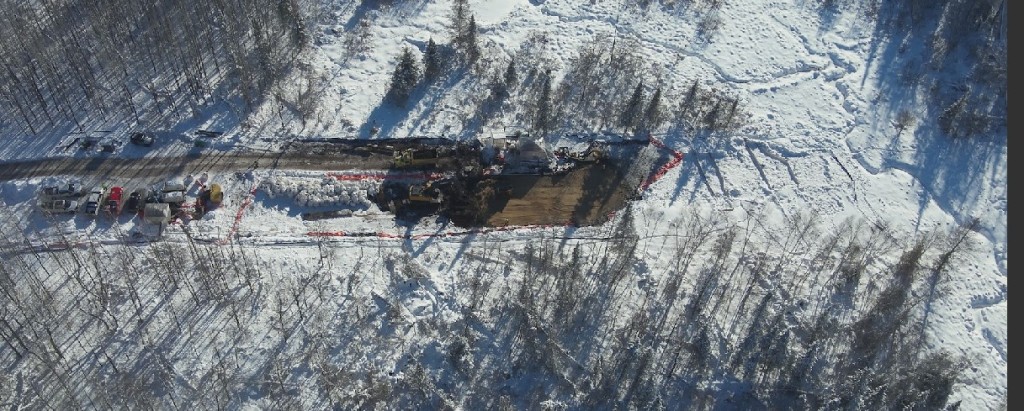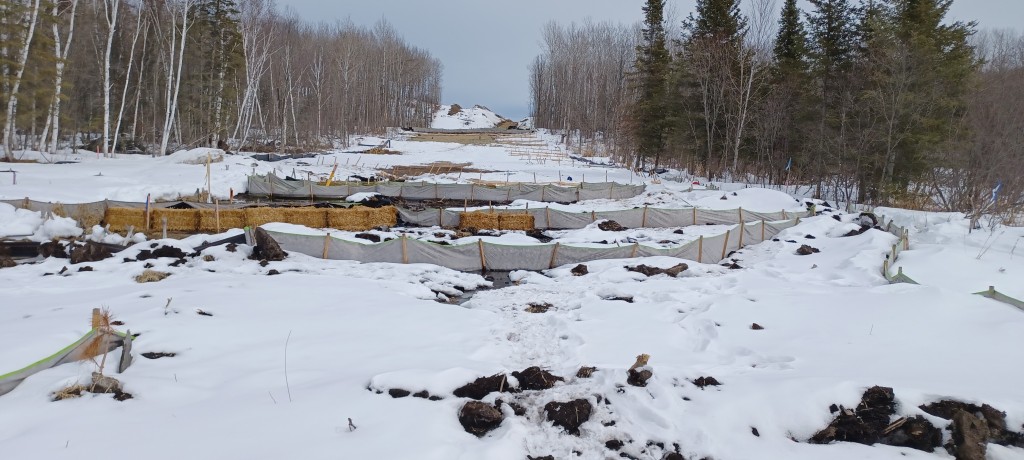And would they do anything different for the next pipeline proposal?
The Minnesota Department of Natural Resources (DNR), Minnesota Pollution Control Agency (MPCA) and Minnesota Public Utilities Commission (PUC) seemed to have had an unfounded confidence that Enbridge would follow the rules while building its new Line 3/93 tar sands pipeline across 337 miles of northern Minnesota.
As we now know, Line 3/93 construction resulted in three significant aquifer breaches and extensive water problems in Walker Brook Valley.
All were preventable. There is likely more damage than currently made public.
Fox 9 News recently did an extensive investigative piece on Line 3-related environmental damage, problems that have not received the attention they deserves from mainstream media. The Fox 9 report drew on the work of the citizen’s volunteer group Waadookawad Amikwag (Anishinaabe for Those Who Help Beaver), which continues to monitor the Line 3/93 corridor. (Click here for their blog on the Fox 9 report.)
Here’s a recap of how Enbridge breached aquifers and the public trust:
Clearbrook: On Jan. 26, 2021 Line 3 workers breached an artesian aquifer in Clearwater County near Enbridge’s Clearbrook Terminal.
An artesian aquifer is water stored under pressure below ground, held in place by an impervious cap, often clay. If that cap is broken, water rushes to the surface.
Line 3 workers deviated significantly from Line 3 construction plans at Clearbrook, according to the DNR. Enbridge’s approved plan called for digging a trench eight-feet deep. Instead, Line 3 workers dug an eighteen-foot deep trench and drove sheet pilings 28 feet deep, breaching the aquifer cap, allowing groundwater under pressure to rush to the surface.
Enbridge should have reported the breach to the DNR immediately. DNR staff didn’t learn about it until June 15 – more than four months after it occurred. The public didn’t learn about the breach for six months after it happened.
The reporting delay and the aquifer breach were both permit violations.
The Clearbrook breach released 72.8 million gallons of groundwater. The repair required pumping at least 547,692 gallons of grout (think cement) into the ground. (For a visual, that’s enough grout to build a wall two-feet thick, 15-feet high, and .46 miles long.)
DNR Commissioner Sarah Strommen called Enbridge’s actions a “clear violations of state law and also of public trust.”
Comment: We have yet to hear an explanation about why Enbridge went so far off script. I struggle to believe that it was simply an accident. The DNR has issued strong words about Enbridge’s violation of public trust, but the sanctions it issued are insignificant to a large multinational company like Enbridge.
LaSalle Valley: LaSalle Creek is a small trout stream in Hubbard County which meanders through a heavily forested glacial tunnel valley.
Before Line 3 construction began, experts warned the Minnesota Public Utilities Commission (PUC) and the DNR this was the worst possible place for a pipeline.
DNR hydrologists evaluated this site “and worked with Enbridge to identify construction practices that could address the unique hydrology of the wetland and stream,” the DNR wrote the PUC Nov. 22, 2017.
During construction, workers drove sheet pilings 28 to 30 feet deep into the ground. Around Aug. 2, 2021, they ruptured an aquifer cap, which was only 12 to 18 feet underground.
Randall Doneen, the DNR’s point person on Line 3 permits, said Enbridge reported the planned trench depth, but not the depth of the sheet piling: “It would have made a difference to us.”
Doneen said he didn’t think Enbridge was trying to hide anything from the DNR. It was “miscommunication,” he said.
“They didn’t want to do an aquifer breach any more than we did.”
That statement surprised me. In a follow-up interview, I reminded Doneen that Enbridge had failed to report the Clearbrook breach for months. I asked what reassured him that Enbridge cared as much about the environment as the DNR, given its multiple aquifer breaches?
“I can’t speak to their intent,” Doneen said. “They are very responsive when we require data or certain activities.”
I speculated that Enbridge might cut corners if it helped its bottom line. They would get a revenue boost from getting the new and larger crude oil pipeline up and running as soon as possible. That might more than offset the cost of fines and repairs the DNR required.
“I wouldn’t know,” Doneen said.
The LaSalle breach released 9.8 million gallons of groundwater and required 51,000 gallons of grout to “fix”.
The DNR considered the LaSalle Valley aquifer breach a permit violation, Doneen said. It was never officially designated as such. Instead, the DNR negotiated an agreement with Enbridge around repairs.
“It’s easy to say we should have had more site specific analysis at LaSalle,” he said, adding it was a challenge with the timeline.
Comment: Everyone knew that LaSalle Valley was a high-risk crossing. It had received extra attention. I struggle to believe this breach was a communications error.
St. Louis County, near the Fond du Lac Reservation: Line 3/93 runs through St. Louis County and the Fond du Lac Reservation. At one part, it crosses a swamp-shrub carr wetland, which the DNR describes as areas “waterlogged much of the growing season and often covered with as much as six inches of water.”
In late January, 2021, workers drove sheet pilings up to 27 feet into the ground.
The groundwater release didn’t start until Sept. 10, 2021, when crews used a vibration hammer to loosen and remove the sheet pilings from surrounding soils, damaging the aquifer cap.
Apparently Enbridge hadn’t done — nor did the DNR require — any hydrological research of the area before construction began. “No historical geotechnical information was available for this site,” Enbridge wrote the DNR on Sept. 27, 2021, as it was trying to understand the breach.
It turned out the aquifer cap was made of particularly fragile soils.
This breach would release 263 million gallons of groundwater, take a year to “fix,” and require pumping 150,000 gallons of grout into the ground.
Comment: It’s difficult to understand why the state would OK construction with so little information. It raises the question whether the state’s environmental impact statement (EIS) was thorough enough, and why the PUC ever approved it.
Doneen said the DNR considers all of the breaches fixed at this point. (He also said the LaSalle Valley breach is difficult to assess, as the hillside includes natural springs.)
Walker Valley: Line 3/93 workers continued this year to fix a significant water problem in the Walker Brook Valley. “Walker Brook was not understanding how much subsurface water was traveling down the hillside. A lot more water than anticipated,” Doneen said.
After workers dug the trench and laid the pipeline downhill, water followed the path of least resistance. Water ran down the hill and knocked down the erosion control barriers, Doneen said. The “fix” involved excavating an extensive amount of soils, and replacing them with a sterile sand and gravel base that would allow the water to flow underground more easily in a broader corridor.

Should the DNR have known about this problem?
“You can speculate,” Doneen said. “It’s easy for people to say ‘You should have …’”
Did this occur because the state didn’t have sufficient time to conduct an adequate EIS?
“Could more time been taken? Yes,” Doneen said. “Would it have changed decisions? It’s hard to say.”
Still, Doneen said the EIS deadlines “are terribly short. … I would be the first one to tell you those time frames are unrealistic.”
Comment: Anyone who followed this process knew the EIS was grossly inadequate, with little to no site specific information, such as the hydrology of Walker Brook or the swamp shrub-carr wetland in St. Louis County. The DNR has yet to make a public statement about the Walker Brook damage, and what if any consequences Enbridge will face for it.
To be clear, the Minnesota Department of Commerce, not the DNR, conducted the EIS. The PUC, not the DNR, issued the Enbridge Line 3 Route Permit.
Still, the DNR could have denied Line 3 permits and stopped the project.
State rules say that pipeline routes, particularly those that run underground, should avoid wetlands. More than 20 percent of Line 3’s PUC-approved route goes through wetlands. Regulators had a ready reason to say “no.”
About those Dewatering Permits ….
Line 3 workers were trenching through many wetlands and other areas with high water tables. As soon as they started digging, the trench would fill with water. Enbridge sought a DNR permit to pump water out of the trenches so they were dry enough to lay pipeline.
During the Line 3 permitting process, Line 3 opponents were frustrated and angry over the amount of “dewatering” the DNR allowed Enbridge to do.
The DNR approved Enbridge’s initial request to dewater 511 million gallons. Soon after, Enbridge quietly applied for a permit amendment allowing it to dewater nearly 5 billion gallons, a nearly ten-fold increase. The DNR approved it.
The White Earth Nation and others worried about dewatering’s impact on wild rice, especially during a drought. White Earth Chairman Michael Fairbanks came to the Capital to ask Gov. Walz to block the permit. (Walz didn’t.)
After the pipeline was finished, the dewatering permit expired. Enbridge still had repair work to do, such as at LaSalle Valley and Walker Brook. Enbridge got another DNR permit to dewater one billion gallons, expiring at the end of 2023.
I was surprised to learn that the total amount of dewatering done, including construction and repairs, was only 800 million gallons of groundwater.
So why did the DNR OK dewatering 5 billion gallons of groundwater?
Obviously, it was an overestimate, Doneen said. It’s difficult to estimate because you don’t know about precipitation. Enbridge wanted to be careful not to underestimate it again, he said.
Comment: The DNR’s secretive handling of the dewatering permit created a lot of stress for Anishinaabe communities up north. I find it hard to believe that Enbridge’s consultants could have been that far off on their estimates. Authorizing 5 billion gallons of dewatering has the feeling of giving Enbridge a blank check.






big money talks!! wish we could get the pipelines out of our bad river
rice beds!! bud
LikeLike
MN state employees have stock in Enbridge via their retirement plans. Denying a permit to Enbridge would therefore have personal implications. Shutting down the pipelines even more so. To me, this is a clear conflict of interests and is blatantly unethical. I’d love to see an investigative piece about how state employees, including the ones making these decisions, would be impacted financially if Enbridge was truly held accountable for their errors, denied permits, and if the mainline was shut down.
LikeLike